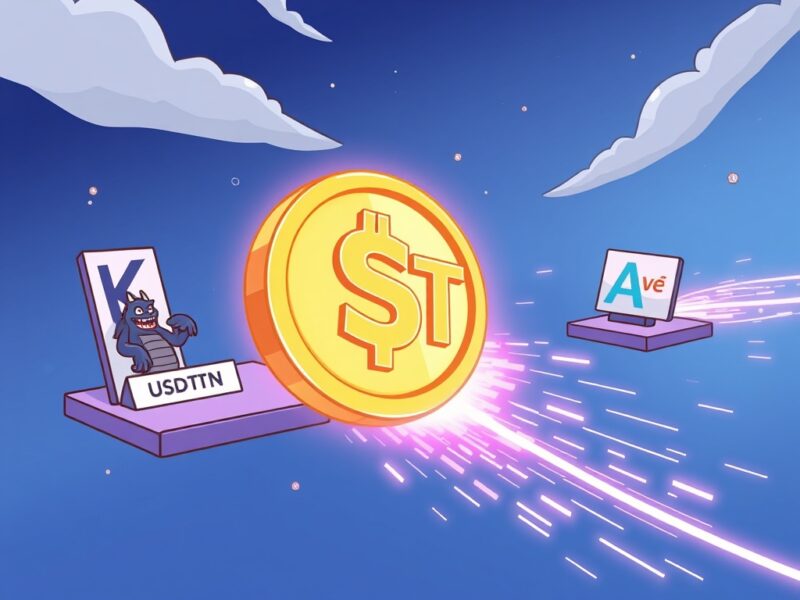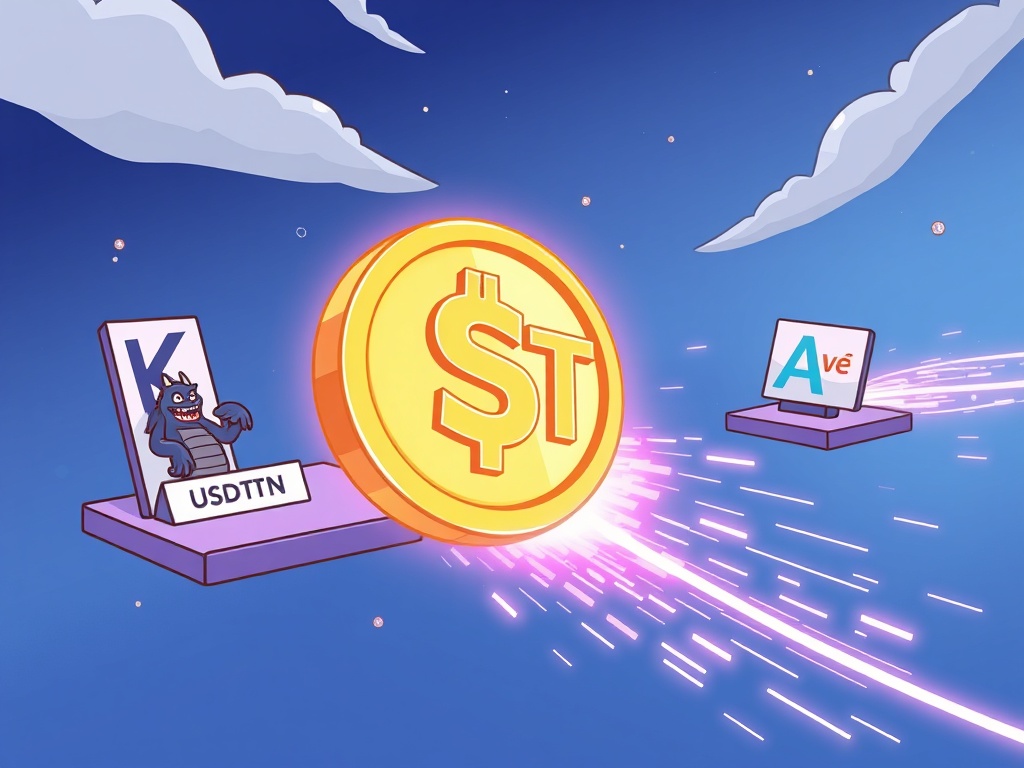Massive USDT Transfer Unveiled: 410,000,000 USDT Moves from HTX to Aave
0
0

BitcoinWorld

Massive USDT Transfer Unveiled: 410,000,000 USDT Moves from HTX to Aave
The cryptocurrency world often witnesses monumental movements of digital assets, and a recent event has captured significant attention. A colossal USDT transfer, totaling 410,000,000 USDT, has been reported moving from the HTX exchange to the decentralized finance (DeFi) lending protocol, Aave. This transaction, valued at approximately $410 million, represents a substantial shift of capital and immediately raises questions about its implications for the broader crypto market.
What Happened? Unpacking the USDT Transfer
On-chain analytics platform Whale Alert recently flagged this massive movement, highlighting the transfer of 410 million Tether (USDT) tokens. USDT is a stablecoin pegged to the US dollar, making its value relatively stable. Such a large USDT transfer from a centralized exchange like HTX to a DeFi platform like Aave is not an everyday occurrence and suggests a strategic move by a significant market participant, often referred to as a “whale.”
HTX and Aave: A Quick Overview
To fully grasp the significance of this event, it is helpful to understand the entities involved:
- HTX (formerly Huobi): This is a major centralized cryptocurrency exchange, offering various trading services. Users typically hold their assets here for trading or safekeeping.
- Aave: A leading decentralized lending and borrowing protocol. Users can deposit cryptocurrencies to earn interest or borrow against their holdings without traditional intermediaries.
The shift from a centralized exchange to a DeFi protocol indicates a potential change in strategy for the funds involved, moving from a trading-centric environment to one focused on earning yield or leveraging assets within the decentralized ecosystem.
Why Does This Massive USDT Transfer Matter?
A USDT transfer of this magnitude can have several profound implications, influencing market sentiment, liquidity, and even the stability of certain protocols. It’s not just a number; it’s a signal.
- Liquidity Shift: Moving $410 million in USDT to Aave significantly boosts the liquidity available within that protocol. This can impact borrowing rates and the overall capacity for lending.
- Strategic Positioning: Whales often make such moves to position themselves for future market events. This could involve preparing to borrow other assets, earning passive income through lending, or even setting up for large-scale arbitrage.
- Market Confidence: A large inflow of capital into a DeFi protocol like Aave can be seen as a vote of confidence in its stability and earning potential, especially for stablecoins.
Potential Market Implications
While the immediate impact might be subtle, such a substantial USDT transfer can ripple through the market. For instance, increased USDT liquidity on Aave might lower borrowing costs for other assets, making it cheaper for traders to open leveraged positions. Conversely, if the whale intends to borrow a significant amount of another asset, it could affect that asset’s market dynamics.
Understanding Whale Movements and Their Impact
Whales, individuals or entities holding vast amounts of cryptocurrency, often move markets with their actions. Tracking these large transactions provides valuable insights into potential future trends or strategies. When a whale moves funds from an exchange to a DeFi platform, it often suggests an intent to engage with decentralized applications rather than just trading on a CEX. This particular USDT transfer could indicate a long-term strategy to utilize Aave’s yield-generating opportunities or prepare for a major borrowing event.
What Could Be Next? Actionable Insights
For everyday crypto enthusiasts, understanding these whale movements can offer crucial insights:
- Monitor Liquidity: Keep an eye on Aave’s USDT liquidity pools. A sudden influx can change lending/borrowing dynamics.
- Observe Related Assets: If the whale intends to borrow, which assets might they target? This could hint at future price movements.
- Stay Informed: Use on-chain analytics tools to track similar large transactions. Knowledge is power in the fast-paced crypto market.
While we cannot predict the exact intentions behind every large USDT transfer, observing these significant movements helps us piece together the larger narrative of the crypto landscape. This particular transaction underscores the growing maturity and utility of DeFi protocols like Aave, even for the largest market participants.
The recent 410,000,000 USDT transfer from HTX to Aave is a clear example of how significant capital moves within the crypto ecosystem. It highlights the strategic decisions made by major players and the increasing importance of decentralized finance platforms. Such a colossal shift can influence market liquidity, borrowing rates, and overall sentiment, making it a transaction worth observing closely. It’s a reminder that even stablecoin movements can carry substantial weight in the dynamic world of digital assets.
Frequently Asked Questions (FAQs)
Q1: What is USDT?
A1: USDT, or Tether, is a stablecoin designed to maintain a stable value, pegged 1:1 with the US dollar. It is widely used in the crypto market for trading, lending, and as a store of value.
Q2: What are HTX and Aave?
A2: HTX (formerly Huobi) is a major centralized cryptocurrency exchange where users can trade and store digital assets. Aave is a leading decentralized finance (DeFi) protocol that allows users to lend and borrow cryptocurrencies without intermediaries.
Q3: Why do large USDT transfers occur?
A3: Large USDT transfers often occur for strategic reasons, such as increasing liquidity on a DeFi platform, preparing for significant trades, earning yield through lending, or rebalancing portfolios. They usually signal a deliberate move by a major investor or institution.
Q4: How does this specific USDT transfer affect the crypto market?
A4: This specific USDT transfer of $410 million to Aave primarily boosts the liquidity within the Aave protocol, potentially influencing borrowing rates. It can also signal increased confidence in DeFi and may precede further strategic actions by the whale, which could impact related asset prices.
Q5: Is this USDT transfer a sign of market manipulation?
A5: Not necessarily. While large movements can precede significant market events, a USDT transfer to a lending protocol like Aave is typically for yield generation or leveraging, rather than direct market manipulation. On-chain transparency allows for monitoring such movements, which helps reduce the risk of hidden manipulation.
Did this analysis of the massive USDT transfer spark your interest? Share this article with your network and join the conversation about whale movements and their impact on the crypto market!
To learn more about the latest crypto market trends, explore our article on key developments shaping DeFi protocols and their price action.
This post Massive USDT Transfer Unveiled: 410,000,000 USDT Moves from HTX to Aave first appeared on BitcoinWorld and is written by Editorial Team
0
0
 Manage all your crypto, NFT and DeFi from one place
Manage all your crypto, NFT and DeFi from one placeSecurely connect the portfolio you’re using to start.







